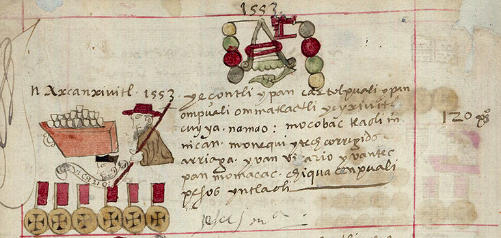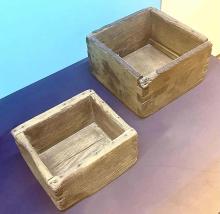tlaolli (CST8)
tlaolli (CST8)
This painting of the simplex glyph for the term tlaolli shows a container with dried corn kernels at the top. This appears to be the measure called either fanega (a loan from Spanish that measures about 1.5 bushels) or the almud another Spanish loanword (which originally came from al-mudd, a dry measure in Arabic, and before that from Latin modius). The measuring instrument is shown in a profile view, facing left. It is apparently made of wood, it has a point on the left end, and a small handle appears just below the point. The kernels are white.
Stephanie Wood
While the word “almud” does not appear in the text next to this glyph, it is a word that did enter Nahuatl from Spanish and is still in used today as (almoh) in Eastern Huastecan Nahuatl. The pueblo of Tepatepec, Hidalgo, offers an image of an almud on line. For more on the Codex Sierra, see Kevin Terraciano’s study (2021). For a fanega of grain see the glyphs below (for wheat, from CST40, or maize kernels, from CST41).
Stephanie Wood
1550–1564
Jeff Haskett-Wood
almoh, almo, almudes, fanegas, granos, agricultura, comida
These wooden grain measuring boxes may represent what are called fanegas or almudes in Spanish. These two “medidas para granos” shown here are in the museum of the city of Guadalajara. They are different sizes: on the left, 11.3 by 17 centimeters, and on the right, 13.5 by 23.9 centimeters. Photo by S. Wood, 15 April 2025.

tlaol(li), dried maize kernels, https://nahuatl.wired-humanities.org/content/tlaolli
almud, a dry measure, https://nahuatl.wired-humanities.org/content/almud
granos de maíz
Stephanie Wood
Códice Sierra-Texupan, plate 8, page dated 1553. Origin: Santa Catalina Texupan, Mixteca Alta, State of Oaxaca. Kevin Terraciano has published an outstanding study of this manuscript (Codex Sierra, 2021), and in his book he refers to alphabetic and “pictorial” writing, not hieroglyphic writing. We are still counting some of the imagery from this source as hieroglyphic writing, but we are also including examples of “iconography” where the images verge on European style illustrations or scenes showing activities. We have this iconography category so that such images can be fruitfully compared with hieroglyphs. Hieroglyphic writing was evolving as a result of the influence of European illustrations, and even alphabetic writing impacted it.
https://bidilaf.buap.mx/objeto.xql?id=48281&busqueda=Texupan&action=sear...
Images of the digitized Florentine Codex are made available under the following Creative Commons license: CC BY-NC-ND (Attribution-NonCommercial-NoDerivs 4.0 International). For print-publication quality photos, please contact the Biblioteca Medicea Laurenziana ([email protected]). The Library of Congress has also published this manuscript, using the images of the World Digital Library copy. “The Library of Congress is unaware of any copyright or other restrictions in the World Digital Library Collection. Absent any such restrictions, these materials are free to use and reuse.”







